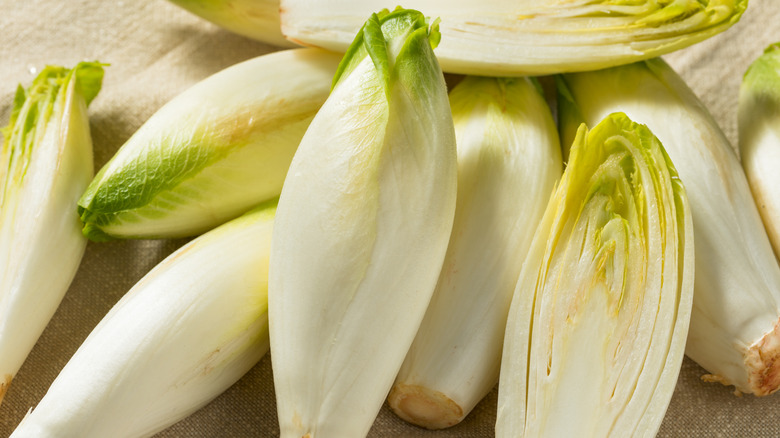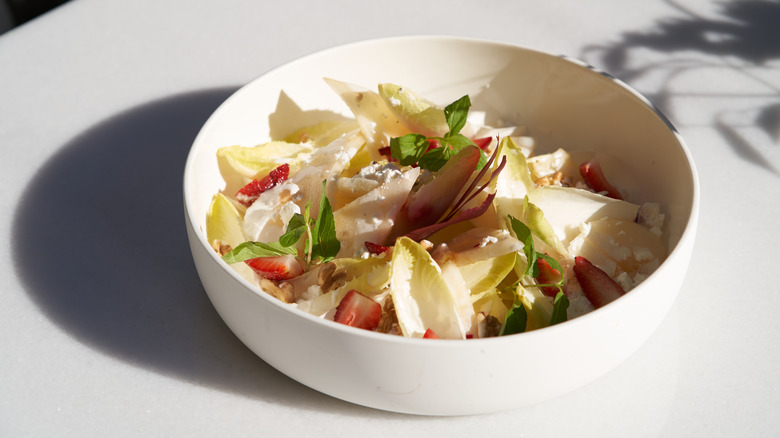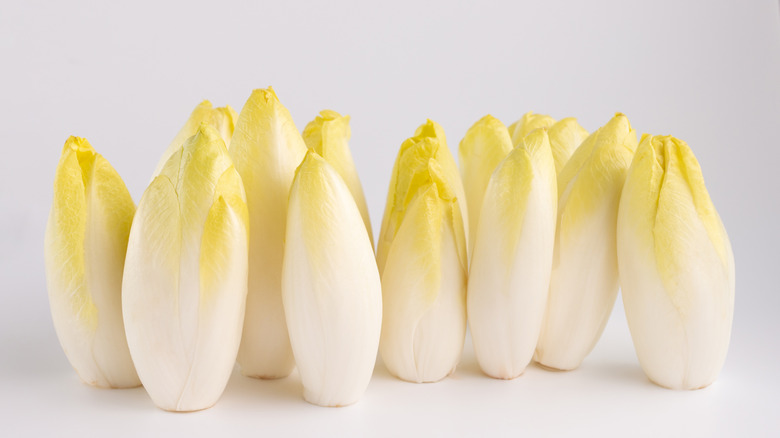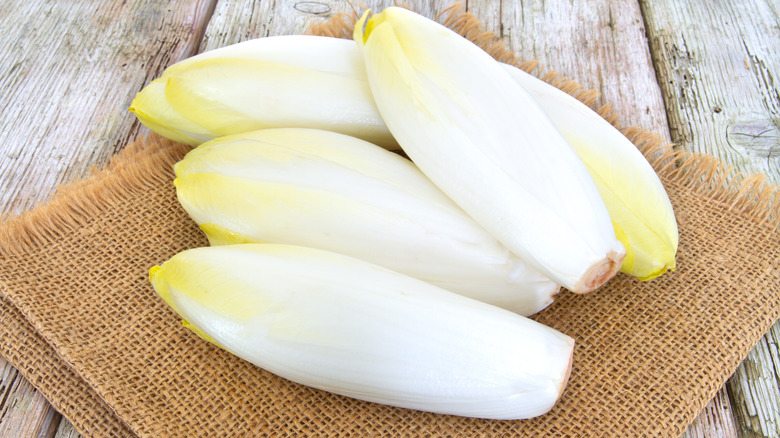What Is Endive And What Does It Taste Like?
You know romaine, kale, and maybe even Swiss chard. But one member of the greens family you may be less familiar with is endive, or Belgian endive if you want to be formal about it. Christened by Bon Appétit as "a chip and a salad green" at the same time, endive is a crisp, pale member of the chicory family — a group of greens that also includes escarole, radicchio, and frisée.
According to the Daily Garden, Belgian endives get their pale color from being grown indoors, in the dark. This unique way of growing means endive is technically always in season! When not grown indoors, they're traditionally grown in winter and covered in sand to keep the light from reaching them.
Chicories are known for being more on the bitter side of the flavor spectrum, and endive is no different. However, those intimidated by harsh flavors needn't fret, as Bon Appétit explains endive has an "extremely mild bitterness" compared to its more intense chicory siblings.
What does endive taste like?
Unlike other members of the chicory familiar, eating endive is truly a delicate experience. Its light color is matched by a light, slightly bitter taste. Due to its mild bitterness, endive can truly shine when incorporated into dishes that feature sweet and sour notes. When enjoyed raw, endive is incredibly crisp. Endive takes on a whole new flavor and texture when cooked. They become soft and tender when braised in white wine, per The Spruce Eats, or smoky and charred when seared over high heat (via Food & Wine).
Endive is sometimes conflated with escarole, but they're much different — endive is paler and more cylindrical, whereas escarole is more bitter and has a deeper green color. Escarole is often more frilly and lettuce-esque.
Can't decide how to use your endive? One of the benefits endive has for home cooks is its long shelf life. Once it's nestled safely in the crisper drawer, it will last for anywhere from 14 to 28 days (via University of California, Davis). With long-lasting endive on your side, any day can have a bit more crunch.
Nutritional information about endive
Endives are a great source of calcium, fibers, potassium, as well as vitamins A, C, E, and K. Of course, endive is also suitable to eat on almost any diet — from keto and paleo to vegan or gluten-free. It also is low-sodium. Well and Good notes that endive contains kaempferol, which has anti-inflammatory properties, as well as numerous vitamins, folate, and more.
Endive.com notes that endive is only one (!) calorie per leaf, is a good source of potassium, may reduce the risk of ovarian cancer, is high in fiber, promotes digestive health, and is delicious both cooked and raw. Due to its high folate content, endive may even be considered helpful and nutritious to those who are pregnant. There is 1 gram of fat in a head of an endive, and they are very low in carbohydrates. So versatile and healthful!
How to cook with endive
From a cultivation perspective, endive is especially challenging to grow and has two separate growing periods, which is somewhat similar to mushrooms. While it may seem like a relatively modest ingredient, a lot of work was necessary to bring that endive to your plate, so — as always — be sure to respect the ingredient and the labor that went into its production (via Endive.com). Its color can be pale, but it may also sometimes be green-tinted. The stem (or core) is hard and fibrous and should be removed prior to eating, along with the bottom end, which is usually a darker color. If you're working with endive that isn't the freshest, you usually will be able to just remove some of the outer leaves and the inner ones should be good to go.
Like other crisp, delicate greens out there, one of the most popular uses for endive is in salads. Because it doesn't have an assertive flavor, endive works in salads alongside bold flavors like cheese, garlic, and even anchovies. The New York Times recommends pairing endive with blue cheese dressing, while Epicurious suggests crunchy apples, walnuts, and apple cider vinegar.
Endive is often described as a "chip" for a reason. Endive's crisp leaves do resemble a vessel for dip. As Kitchen Stories notes, endive's "snappy, crisp bite" makes it an excellent 'vehicle' for eating dips or spreads. It can be paired well with a complex green goddess dip, and Southern Living fills the leaves with a tangy herbed goat cheese. Endive pairs well with anything especially fatty or creamy because its sharp, piquant bite cuts right through the fat. If you're craving a warmer plate, endive is really delicious grilled, as well as roasted, sautéed, or used as an ingredient in pasta — the list goes on and on. It's also stellar with some citrus, oil, salt, and pepper to enhance its delicate flavor.



